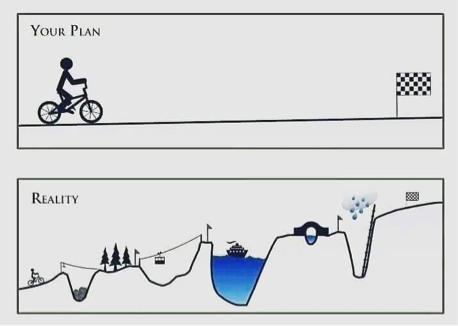PSYCHOLOGY OF US
YOUR RESOURCE LIBRARY
Steps You Can Take Now to Un-Stick
These four steps address common ways of thinking that may be causing your stuckness. Changing them will help you to move forward in the present and, over time, will positively change your way of thinking.

1. Visualise success the right way
Do you have a realistic view of your goal?
When we think about our goals, that goal image is never a true reflection of reality. Rather, it is a mental image that is shaped by our unique beliefs, values, and experiences. We can’t control the subjective nature of our imagination, but we can control what we choose to focus on (1).
If my mind can conceive it, and my heart can believe it – then I can achieve it. Muhammad Ali
Possible thinking versus positive imagery
Motivation researcher, Gabrielle Oettingen, set out to explore whether positive visualisation helps people achieve their goals. The studies found that fantasising about reaching our goals may actually stop us from moving towards them (2).
This is because our brains have difficulty telling the difference between real and imagined scenarios. So, when we visualize success, our brains release dopamine (responsible for pleasure and reward) and we feel relaxed. In this relaxed state, participants were less motivated and were more likely to get frustrated and give up when challenges arose.
Visualisation is a common practice in professional sports. Seasoned athletes don’t just visualize their wins – they visualise the steps it takes to get there. Muhammad Ali used self affirmations such as, I am the greatest!, but he also mentally rehearsed vivid and detailed fight scenarios (3).
Research has established that the most effective visualisation techniques include:
- mentally practising all of the steps
- engaging all of the senses
- envisioning multiple scenarios
- recognising weaknesses
- focusing on small improvements.
As a result of her findings, Oettingen came up with an exercise called WOOP to help you create a clear and more realistic path to your goal. Visit The Right Way to Visualise Success to give it a go.
2. Separate your achievements from your self-worth
Since school age we have been compared to others and measured by our performance. Students are taught that it takes both effort and ability to perform well. However, students quickly learn that grading systems and exams reward their ability over their effort.
As adults we continue to confuse our achievements (or lack thereof) with our self-worth and we often beat ourselves up if we make mistakes or fail. As a result, we are more likely to focus on our shortcomings rather than problem solve and rectify situations. This means that we don’t learn from our mistakes and try again.
Procrastination and avoidance become coping mechanisms to evade the negative impact on our self-worth caused by trying and failing. Having strategies in place to protect our self-worth both strengthens our resilience to negative feedback (from others and from ourselves) and means we are more likely to learn from mistakes.
3. Build your self-compassion, not your self-esteem
One strategy that builds our resilience is employing an internal support system. Self-compassion is giving yourself the support that you would give your best friend. It is the ideal supportive relationship.
Self-compassion is not only healthy, it is effective in helping us unstick.
Self-esteem is fragile; it can vary from day to day. It is often based on evaluation of our achievements and how they compare to others. Ignoring, glossing over, or deflecting our mistakes are common coping strategies when we continually try to pump up our self-esteem. On the other hand, self-compassion allows us to face our mistakes. Like a nurturing parent, self-compassion views our mistakes with empathy and patience (4).
Internalise a supportive coach, teacher, therapist, mentor, or friend. When self-correcting, emulate the constructive tone of someone who has been supportive, understanding, and constructive – someone who accepts all parts of you, strengths and limitations (5). If you can’t think of a personal example, visualise your ideal supporter.
4. Change your resistance mindset
In terms of motivation, resistance is the internal process of pushing against or holding back change. Resistance is the stickiness that keeps us from moving forward; it is our attitude, thoughts, feelings, and behaviours that thwart our progress.
Above we talked about our tendency to link our self-worth with our ability to achieve our goals. One of the downsides of this tendency is that we also link our self-worth with our inability to get things done. However, we are not the obstacles that appear before us.
In other words, you are not your resistance.
Do the Work author, Steven Pressfield, suggests that we thinking of our resistance as an external force, a resistance dragon (6). You can choose to fight your resistance dragons or befriend them, find out how: here.
References and Contributors
- Nick Hall. (2007). I Know What To Do, So Why Don’t I Do It?
- Gabriele Oettingen. (2014). Rethinking Positive Thinking: Inside the New Science of Motivation.
- Louis Collins. (2014). The Vital Edge.
- Paul Gilbert. (2010). The Compassionate Mind.
- Mary Welford. (2013). The Power of Self-Compassion: Using Compassion-Focused Therapy to End Self-Criticism and Build Self-Confidence.
- Steven Pressfield. (2015). Do the Work: Overcome Resistance and Get Out of Your Own Way.
How therapy works
Worksheets and useful information
Creative Process
Feeling Stuck
Stress
Depression
Feeling Down
Anxiety
Guilt and shame
Find out more
What I do differently
Monkey Therapy
Transformational Coaching
Online Therapy
Trauma
Your inner critic
The science behind it
Steps you can take now
Publications
More than CBT
More than IFS
Psychedelics
Neurodiversity
Thank you!
Your message has been sent. We'll contact you shortly
© 2023 The Monkey Therapist. All Rights Reserved. Site Designed By Samantha Ósk
PRIVACY POLICY